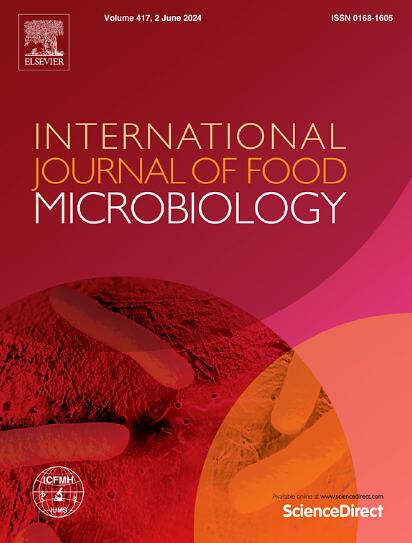Biofortification of fermented foods with riboflavin-overproducing Bifidobacterium longum subsp. infantis strains
IF 5
1区 农林科学
Q1 FOOD SCIENCE & TECHNOLOGY
International journal of food microbiology
Pub Date : 2025-04-15
DOI:10.1016/j.ijfoodmicro.2025.111210
引用次数: 0
Abstract
Fermented food matrices with probiotic cultures capable to enrich the content of riboflavin in the final product, and capable to deliver metabolically active strains, is an appealing alternative to prevent the issues associated with this vitamin deficiency. In this work two riboflavin-overproducing B. longum subsp. infantis strains, IPLA60015 and IPLA60012, were investigated for the elaboration of fermented drinks based on dairy and almond drink matrices. Dairy fermented products showed the highest riboflavin concentrations upon one month of refrigerated storage. The concentration of vitamin in milks fermented with a single riboflavin overproducing bifidobacterial culture, was higher than that obtained in co-culture with several yogurt starters, or that present in commercial yogurts. Besides, following simulated in vitro digestion of the biofortified products, between 59.8 and 84.6 % of the riboflavin present in the fermented foods were detected, the highest recovery occurring in the fermented dairy matrix fermented with strain IPLA60012. These results set the ground to facilitate the incorporation of novel riboflavin producing bifidobacterial cultures into fermented matrices.
富含核黄素的长双歧杆菌亚种对发酵食品的生物强化。对象的菌株
含有益生菌培养物的发酵食品基质能够丰富最终产品中核黄素的含量,并能够提供代谢活跃的菌株,是预防与这种维生素缺乏症相关问题的一种有吸引力的替代方案。本文研究了两种过量产生核黄素的长芽孢杆菌。以婴儿菌种IPLA60015和IPLA60012为研究对象,以乳制品和杏仁饮料为基质制备发酵饮料。乳类发酵产品在冷藏一个月后核黄素含量最高。用单一核黄素过量双歧杆菌培养发酵的牛奶中维生素的浓度高于与几种酸奶发酵剂共同培养或在商业酸奶中存在的浓度。此外,对生物强化产品进行体外模拟消化后,发酵食品中核黄素的回收率为59.8% ~ 84.6%,其中以菌株IPLA60012发酵的乳制品基质中核黄素回收率最高。这些结果为促进将新型核黄素产生双歧杆菌培养物纳入发酵基质奠定了基础。
本文章由计算机程序翻译,如有差异,请以英文原文为准。
求助全文
约1分钟内获得全文
求助全文
来源期刊
CiteScore
10.40
自引率
5.60%
发文量
322
审稿时长
65 days
期刊介绍:
The International Journal of Food Microbiology publishes papers dealing with all aspects of food microbiology. Articles must present information that is novel, has high impact and interest, and is of high scientific quality. They should provide scientific or technological advancement in the specific field of interest of the journal and enhance its strong international reputation. Preliminary or confirmatory results as well as contributions not strictly related to food microbiology will not be considered for publication.

 求助内容:
求助内容: 应助结果提醒方式:
应助结果提醒方式:


